Crosby Hall, London
Crosby Hall is a historic building in London. The Great Hall was built in 1466 and originally stood in Bishopsgate, in the City of London, but was moved in 1910 to its present site in Cheyne Walk, Chelsea. It now forms part of a private residence.
| Crosby Hall | |
|---|---|
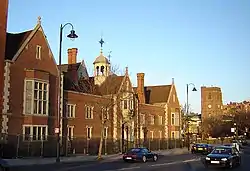 | |
| Location | Cheyne Walk, Chelsea, London |
| Coordinates | 51°28′56.94″N 0°10′21.52″W |
| Built | 1466 (Great Hall and Parlour) 1910, 1925–6 (Remainder) |
Listed Building – Grade II* | |
| Official name | Crosby Hall |
| Designated | 24 June 1954[1] |
| Reference no. | 203744 |
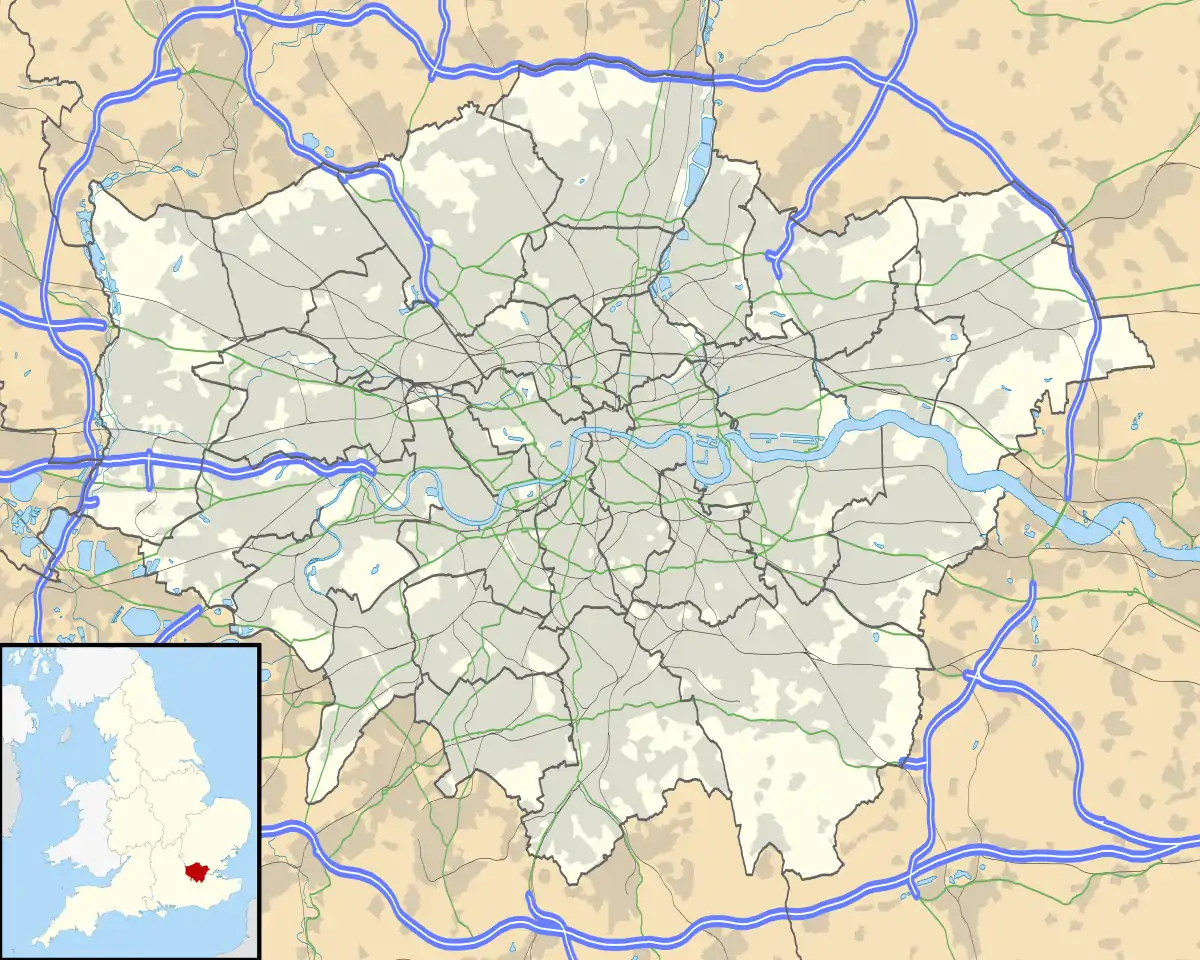 Location of Crosby Hall in Greater London | |
The Great Hall, and additional work of 1910 and 1925–1926, are listed Grade II*.[1] Although fragmentary and not on its original site, this is the only example of a medieval City merchant house surviving in London.[1]
History
Bishopsgate
The Great Hall is the only surviving part of the medieval mansion of Crosby Hall, Bishopsgate, in the City of London. It was built in 1466 on the grounds of St. Helen's Convent across from St. Helen's Church, Bishopsgate by the wool merchant and alderman, Sir John Crosby, a warden of the Worshipful Company of Grocers and auditor of the City of London.[2] The building project completed in 1472 and "Sir John died in 1475, so short a space enjoyed he that sumptuous building."[3] In 1476, the hall was bequeathed to Lady Crosby, his widow, Anne.[4]
Richard III
By 1483, the Duke of Gloucester, later King Richard III, acquired the Bishopsgate property from Lady Crosby.[5] It was used as one of his London homes during the time of the Princes in the Tower.[5][6]
Upon Richard III's arrival from York in May 1483, Robert Fabyan in his Chronicle wrote that "the Duke lodged hymself in Crosbye's Place, in Bishoppesgate Street" where the Mayor and citizens waited upon him with the offer of the Crown.[7] Holinshed's Chronicles described that "little by little all folke withdrew from the Tower, and drew unto Crosbies in Bishops gates Street, where the Protector kept his household. The Protector had the resort; the King in maner desolate."[8]
Crosby Hall was thus used as a setting for several scenes of William Shakespeare's first published play Richard III"[9] in which the Plantagenet King refers to Crosby Hall (then Crosby Place): "When you haue done repaire to Crosby place" (Act I, Scene 3), "At Crosby place there shall you finde vs both" (Act III, Scene 1).[10][11]
Tudor period
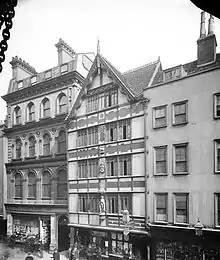
John Stow in his Survey of London (1598) described Crosby Hall as being "of stone and timber, very large and beautiful, and [when first built] the highest at that time in London".[4]
In 1501, Catherine of Aragon resided at Crosby Hall along with her retinue as she arrived in England to marry Prince Arthur, Henry VII's eldest son.[12] At the time, Crosby Hall was owned by Sir Bartholomew Reade, Lord Mayor, who made it his Mansion House and is recorded as throwing extravagant feasts for ambassadors sent by Maximilian I, Holy Roman Emperor.[13] During the Lombard Street riots, several of those taken into custody were confined within Crosby Hall prior to removal to Lambeth Palace.[14]
Crosby Hall then belonged to Thomas More, Lord Chancellor of England to King Henry VIII, although "he probably never lived in it.".[15] He also owned the riverfront estate in Chelsea on which the building now rests.[16] Thomas More's son-in-law William Roper documented that Henry VIII visited More frequently or even unannounced. "At times, too, the king would present himself as an unbidden guest at dinner-time at More's house, and would walk with More about his garden at Chelsea…"[17] It is "often…accepted" that More wrote the second part of his Utopia while residing at Crosby Hall, although this is unlikely, given the work's publication date of 1516, at least three years before More took possession.[18][19]
In 1523, Thomas More sold the remainder of his lease in Bishopsgate to his close friend and patron, the wealthy Anglo-Italian merchant, Antonio Bonvisi.[20][21] Bonvisi protected the lease of the mansion in various arrangements following More's execution and throughout the Dissolution of the Monasteries, which affected freeholds under the "Priory of St. Eleyns" including that of Crosby Place.[22] In 1547, upon the death of Henry VIII, Bonvisi leased the mansion back to Thomas More's nephew, William Rastell, and Thomas More's son-in-law and biographer, William Roper.[23]
Shakespeare resided in the parish of St Helen's Bishopsgate and would have been within daily sight of Crosby Hall, which is referenced several times in Richard III.[24] He was probably familiar with the reputation of Bonvisi, and Antonio is used frequently as a name in his plays.[25]
Crosby Hall was sold in 1594 to the wealthy Alderman John Spencer, Lord Mayor of London, "Rich Spencer", who further enhanced the building, kept his mayoralty there, and was known to thrown lavish banquets with diplomatic flair.[26] Following a dinner in the Great Hall, Spencer forgave a youth accused by the visiting French duke of murdering an Englishman that evening outside Crosby Hall, after which "The English began to love, and the French to fear him more."[27] Spencer entertained Queen Elizabeth I, Shakespeare, the Duc de Sully, the youngest son of the Prince of Orange, other notable figures, and ambassadors.[28]
In 1601, Sir Walter Raleigh, a favoured adviser of Queen Elizabeth I, lodged at Crosby Hall.[1][29] Other residents during the Elizabethan era included the poet Dowager Countess of Pembroke Mary Sidney, one of the most notable writers of her time, following her time at court within the Privy Chamber of Elizabeth I. Sidney most likely resided at Crosby Hall from 1609-1615, when it was owned by the Lord Privy Seal, Henry Howard, 1st Earl of Northampton.[30] Sidney's literary circle included Shakespeare and Ben Johnson, who were guests at Crosby Hall.[31]
East India Company
From 1621 to 1638 the Hall was the home of the East India Company.[32][33] Crosby Hall survived the Great Fire of 1666, but following a fire in 1672 only the Great Hall and Parlour wing of the mansion survived; it then became a Presbyterian meeting house, and then a warehouse with an inserted floor.[1]
From 1835-36, a campaign was launched to save the remainder of the Hall, which had begun to show signs of decay. A Committee chaired by Alderman W. T. Copeland, M.P., then Lord Mayor of London, met at The City of London Tavern at Bishopsgate Street to support the Hall's repair, eventually raising a small sum. However, the majority of the funds needed were provided through a single lady, Maria Hackett, who took over the lease at significant personal expense. Hackett assumed all liabilities, oversaw the laying of stones for an adjoining council chamber, and funded the removal of the inserted floor.[34]
Restaurant

In 1868 Crosby Hall was turned into a sumptuous restaurant and bar by Messrs. Gordon & Co., whose directors were Frederick Gordon and Horatio Davies, later owner of Pimm's and Lord Mayor of London. They bought the freehold in early 1873 for about £37,000.[35]
It was sold in April 1907 for £175,000 to the Chartered Bank of India, Australia, and China whose directors intended to pull down one of the most ancient buildings in the City of London and build a new bank building in its stead.[36] Its impending destruction aroused a storm of protest, and a campaign was once again started to save it.[37]
Chelsea
In 1910, the medieval structure was reprieved from threatened demolition and moved stone by stone from Bishopsgate to its present site in Chelsea. The site was provided by the former London County Council, whilst the salvage, catalogue and storage were paid for by the Chartered Bank of India, Australia, and China, whose directors had purchased the Bishopsgate site to build new offices.[38][39] The architect responsible for the building's relocation and restoration was Walter Godfrey. Neo-Tudor brick additions designed by Walter Godfrey were constructed around it.[39][40] The Queen Mother, then Duchess of York, formally opened Crosby Hall on its Chelsea site in 1926.[41]
World War I
During World War I, Crosby Hall was a refuge for Belgian refugees who fled to Britain and were aided by the Chelsea War Refugee Committee. Henry James wrote Crosby Hall's ''almost incomparable roof has arched all this winter and spring [ 1914-1915 ] over a scene . . . more pathetic than any that have ever drawn down its ancient far-off blessing.''[42] Crosby Hall was the site of concerts held by the War Refugee Committee in aid of the exiles.[43] A commemorative plaque hung in Crosby Hall read as follows:
To commemorate the gratitude of Belgian exiles to the Chelsea War Refugee Committee which from Crosby Hall, during the Great War, dispensed hospitality, organized relief for our persecuted and exiles compatriots and aided our maimed soldiers to regain their independence. 1914-1919
British Federation of University Women
The British Federation of University Women (BFUW) took a long lease on Crosby Hall and employed Godfrey to build a tall Arts and Crafts residential block at right angles to the great hall in 1925–1927.[40][44] The federation raised money for the work through a major campaign reaching out to individual women, industrialists, philanthropists, and Chelsea residents. Two years into the campaign, £17,000 of their initial £25,000 target had been raised. The expanded Crosby Hall included offices for both the British and International Federation of University Women. The residential block was used as a hall of residence for visiting university women, some of whom received IFUW scholarships to travel and study.[45]
Many of the foreign women were spending just the one year in England, and ... as a result felt this year to be one of the greatest experiences of their lives. For this reason the majority of the Crosby Hall residents lived at an enormous pitch of intensity, lifted out of their everyday habits, and this, above all, was what shaped the intellectual life of Crosby Hall.
World War II
With the rise of National Socialism (Nazism) in Germany and the passage of the anti-Jewish Law for the Restoration of the Professional Civil Service on 7 April 1933,[46][47][48] Crosby Hall provided an important source of support for women academics who were being forced out of Germany. The BFUW undertook an additional fund-raising appeal on their behalf, which met with an enthusiastic response. As a result, the BFUW was able to provide 3 new 12-month residential fellowships (in addition to 7 existing ones) as well as smaller awards. In 1934 the new fellowship recipients were Emmy Klieneberger-Nobel, Betty Heimann, and Helen Rosenau. Among many other women who received funding and support were Adelheid Heimann (no relation to Betty), Gertrud Kornfeld, Dora Ilse, and Erna Hollitscher.[45][49]
I cannot describe what it meant to me and other refugees when we were allowed to stay there, after the persecution and hatred that we had undergone in "Greater Germany". In Crosby Hall we were not only tolerated but welcomed, and we found an atmosphere of kindness and understanding which assured us that there was another world outside Nazi Germany in which we might be allowed to live freely, and perhaps happily. I feel sure that everyone who stayed in Crosby Hall felt that atmosphere, from whichever part of the world she came.
Crosby Hall was requisitioned by the war effort, but reopened in 1946.[50]
Greater London Council
The site passed to the Greater London Council (GLC), who maintained it until 1986, when the GLC was abolished. The London Residuary Body, charged with disposing of the GLC's assets, put Crosby Hall up for sale.[51]
Christopher Moran
Crosby Hall was bought in 1988 by Christopher Moran,[52] a businessman and philanthropist who is the Chairman of Co-operation Ireland. Until then the site's frontage had been open to Cheyne Walk and the River Thames and its central garden was open to the public. Moran commissioned a scheme to close the frontage with a new building and convert the complex to a luxury mansion.[53] The scheme caused considerable controversy, but was given eventually permission after a Public Inquiry in December 1996, following two previous refusals by Kensington and Chelsea Council. Moran paid for the building's restoration, including initial stabilization of the Great Hall's 15th-century Reigate stone.[40][44] The garden was restored by the late Dowager Marchioness of Salisbury and only plants found in Tudor England are used.[54][55] The craftsmen were selected by David Honour, former head of design at Historic Royal Palaces.[56]
Notable residents at the original site
- Richard III of England, Duke of Gloucester, 1483[1]
- Catherine of Aragon, 1501[57]
- Bartholomew Reade, Lord Mayor of London, 1501–1505[13]
- Sir Thomas More, Lord High Chancellor of England, 1523–4.[1]
- William Roper (son-in-law of Thomas More), 1547[1]
- John Spencer, Lord Mayor of London, 1594[58]
- Sir Walter Raleigh, 1601.[1]
- The Earl of Northampton between 1609 and 1671,[1]
- Dowager Countess of Pembroke, Mary Sidney from 1609–1615.[59]
- Headquarters of the East India Company, 1621–38[1]
 Crosby Hall
Crosby Hall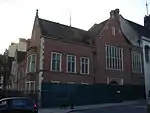 Crosby Hall
Crosby Hall Crosby Hall
Crosby Hall Crosby Hall
Crosby Hall Crosby Hall
Crosby Hall Crosby Hall
Crosby Hall
See also
| Wikimedia Commons has media related to Crosby Hall. |
References
- Historic England. "Crosby Hall (Grade II*) (1358160)". National Heritage List for England. Retrieved 8 January 2017.
- "Crosby Hall Palace of Richard III : London coffee houses and taverns". londontaverns.co.uk. Retrieved 2 February 2020.
- "The history of Crosby Place | British History Online". www.british-history.ac.uk. Retrieved 8 July 2020.
- "The history of Crosby Place". Retrieved 2 February 2020 – via British History Online.
- Amy Licence. Anne Neville: Richard III's Tragic Queen, Amberley Publishing. 2013.
- "Robert Fabyan: 'The Concordaunce of Hystoryes' | Richard III Society - American Branch". Retrieved 29 May 2020.
- Blackburn, Edward L. (1834). An architectural and historical account of Crosby place, London. John Williams.
- "The history of Crosby Place | British History Online". www.british-history.ac.uk. Retrieved 8 July 2020.
- "Local architecture". Royal Borough of Kensington and Chelsea. Archived from the original on 29 April 2010. Retrieved 6 June 2010.
- William Shakespeare (1597). The Tragedy of King Richard the third. London: Andrew Wise. Retrieved 2 February 2020 – via www.pierre-marteau.com. An original-spelling text of the first quarto edition.
- "Richard III, first edition". Shakespeare Documented. Retrieved 2 February 2020.
- Emery, Anthony (9 March 2006). Greater Medieval Houses of England and Wales, 1300–1500: Volume 3, Southern England. Cambridge University Press. ISBN 978-1-139-44919-9.
- Chaffers, William "Gilda Aurifabrorum" pg. 35-36
- "Davidson of Lambeth, 1st Baron, (Most Rev. Randall Thomas Davidson) (7 April 1848–25 May 1930)", Who Was Who, Oxford University Press, 1 December 2007, doi:10.1093/ww/9780199540884.013.u208346
- Weinreb, Ben; Hibbert, Christopher (1983). "Crosby Hall". The London Encyclopædia (1993 ed.). London: Macmillan. p. 219. ISBN 0333576888.
- "CROSBY HALL, Kensington and Chelsea - 1358160 | Historic England". historicengland.org.uk. Retrieved 2 February 2020.
- Lee, Sidney, "More Thomas (1478-1535)", Dictionary of National Biography, 1885-1900, 38, retrieved 8 July 2020
- "The history of Crosby Place | British History Online". www.british-history.ac.uk. Retrieved 8 July 2020.
- Goss 1908, pp. 49–50.
- . Dictionary of National Biography. London: Smith, Elder & Co. 1885–1900.
- "The Center for Thomas More Studies - Home". www.thomasmorestudies.org. Retrieved 2 February 2020.
- Goss 1908, p. 53.
- "Thomas More Comes to Chelsea". www.rbkc.gov.uk. Retrieved 26 February 2019.
- Schwyzer, Philip (26 September 2013). Shakespeare and the Remains of Richard III. OUP Oxford. ISBN 978-0-19-166360-4.
- "The history of Crosby Place | British History Online". www.british-history.ac.uk. Retrieved 8 July 2020.
- Mead, Lucia Ames (1908). Milton's England. Library of Alexandria. ISBN 978-1-4655-1417-2.
- Mead, Lucia Ames (1908). Milton's England. Library of Alexandria. ISBN 978-1-4655-1417-2.
- "Crosby Hall Palace of Richard III : London coffee houses and taverns". londontaverns.co.uk. Retrieved 2 February 2020.
- "London and Its Environs, 1927 13 Chelsea Crosby Hall". www.gardenvisit.com. Retrieved 2 February 2020.
- Goss 1908, p. 89.
- Gordon, Frederick (1868). Crosby Hall, Bishopsgate : its early history and present restoration. London: Marchant, Singer & Co. p. 8.
- Foster 1913.
- "Inhabitants of London in 1638: St. Helen's within Bishopsgate" – via British History Online.
- "The history of Crosby Place | British History Online". www.british-history.ac.uk. Retrieved 25 December 2020.
- Goss 1908, pp. 124–125.
- Goss 1908, p. 127.
- Goss 1908, pp. 127-133.
- Godfrey 1982.
- Godfrey 1913.
- Aslet, Clive (7 July 2011) [April 2009]. "Building the past". Country Life. Retrieved 2 January 2019 – via Dr. Christopher Moran.
- Dyhouse, Carol (1 December 1995). "The British federation of university women and the status of women in universities, 1907-1939". Women's History Review. 4 (4): 465–485. doi:10.1080/09612029500200093. ISSN 0961-2025.
- James, Henry (23 March 1916). "Refugees in Chelsea". Times Literary Supplement (740): 133–34.
- "REMEMBERING THE FIRST WORLD WAR: HOME FRONT - Library". www.library.qmul.ac.uk. Retrieved 7 July 2020.
- Thurley, Simon (30 June 2011) [2003]. "Crosby Hall – 'the most important surviving domestic Medieval building in London'". Country Life. Retrieved 2 January 2019 – via Dr. Christopher Moran.
- Oertzen, Christine von (30 April 2016). Science, gender, and internationalism : women's academic networks, 1917-1955 (1st ed.). Springer. pp. 6–8, 40–43, 127–151. ISBN 978-1-137-43890-4. Retrieved 2 January 2019.
- Manjapra, Kris (6 January 2014). Age of Entanglement : German and Indian Intellectuals Across Empire. Harvard University Press. pp. 86–87, 251. ISBN 9780674725140. Retrieved 17 December 2018.
- Stackelberg, Roderick; Winkle, Sally A. (15 April 2013). "Article 1 First Regulation for Administration of the Law for the Restoration of the Professional Civil Service". The Nazi Germany Sourcebook: An Anthology of Texts. Routledge.
- Freidenreich, Harriet Pass (2002). Female, Jewish, and educated : the lives of Central European university women. Indiana University Press. ISBN 978-0253340993.
- "Aid to Refugees". University Women's International Networks Database. Retrieved 2 January 2019.
- "Crosby Hall : International Residence for University Women". Nature. 164 (4176): 820–821. 12 November 1949. Bibcode:1949Natur.164S.820.. doi:10.1038/164820c0.
- Dyhouse, Carol (1 December 1995). "The British federation of university women and the status of women in universities, 1907-1939". Women's History Review. 4 (4): 465–485. doi:10.1080/09612029500200093.
- "Dr. Christopher Moran, Chairman of Co-operation Ireland". Dr. Christopher Moran. Retrieved 26 February 2019.
- "Crosby Hall - 16th Century Restoration | Christopher Moran". Dr. Christopher Moran. 7 July 2011. Retrieved 8 July 2020.
- "Hall of fame". The Daily Telegraph. 6 October 2003. ISSN 0307-1235. Retrieved 7 July 2020.
- Long, David (30 November 2011). London's 100 Most Extraordinary Buildings: London's 100 Most Extraordinary Buildings. History Press. ISBN 978-0-7524-8030-5.
- "Crosby Hall - 16th Century Restoration | Christopher Moran". Dr. Christopher Moran. 7 July 2011. Retrieved 8 July 2020.
- Emery, Anthony (9 March 2006). Greater Medieval Houses of England and Wales, 1300–1500: Volume 3, Southern England. Cambridge University Press. ISBN 978-1-139-44919-9.
- "Chelsea/ Bishopsgate, Crosby Hall - Item 2153 (Image:D)". historicmedals.com. Timothy Millett Limited. Retrieved 2 February 2020.
- "Mary Sidney". Hausbrandt Trieste 1892 S.p.A. Retrieved 11 July 2020.
Further reading
- Foster, Sir W. (1913). "The East India Company at Crosby House, 1621–38". London Topographical Record. 8: 106–39.CS1 maint: ref=harv (link)
- Godfrey, W. Emil (1982). "Crosby Hall and its re-erection". Transactions of the Ancient Monuments Society. 26: 227–43.CS1 maint: ref=harv (link)
- Godfrey, Walter H. (1913). "Crosby Hall (re-erected)". Chelsea, Pt. II. Survey of London. 4. London. pp. 15–17 – via British History Online.CS1 maint: ref=harv (link)
- Goss, Charles William Frederick (1908). Crosby Hall: A Chapter in the History of London. London: Crowther & Goodman.CS1 maint: ref=harv (link)
- Knight, Charles, ed. (1841). "Crosby Place". London. 1. London: Charles Knight. pp. 317–32.
- Norman, Philip (1909). "Crosby Place". London Topographical Record. 6: 1–22.
- Norman, Philip; Caröe, W. D. (1908). Crosby Place. Survey of London Monograph. 9. London – via British History Online.
- Saint, Andrew (1991). "Ashbee, Geddes, Lethaby and the Rebuilding of Crosby Hall". Architectural History. 34: 206–23. doi:10.2307/1568600. JSTOR 1568600.
- Sweet, Rosemary (2017). "The preservation of Crosby Hall, c.1830–1850". Historical Journal. 60 (3): 687–719. doi:10.1017/S0018246X15000564. hdl:2381/35989.
- Thurley, Simon (2003). "Crosby Hall – 'the most important surviving domestic medieval building in London'". Country Life. Vol. 197 no. 40. pp. 72–5.
External links
- Historic England. "Crosby Hall (Grade II*) (1358160)". National Heritage List for England. Retrieved 8 January 2017.
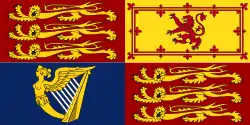
.svg.png.webp)